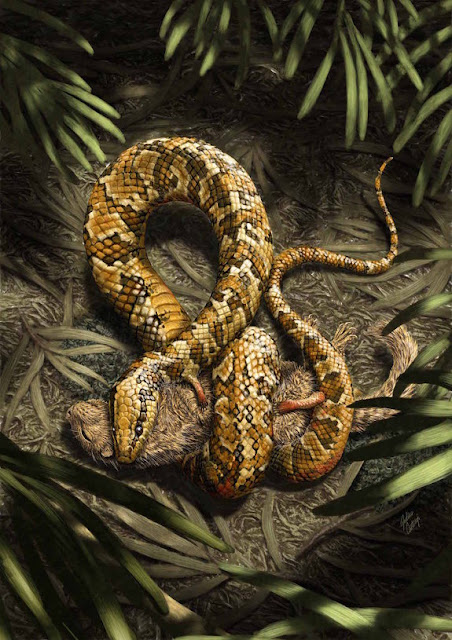While the exact details of snake evolution are still to be worked out, there is no doubt that snakes evolved from four-legged ancestors. We have evidence of snake fossils with small hind limbs such as Najash rionergina [1] and Haasiophis terrasanctus [2] which provide evidence of limb loss in snake ancestors which had adopted a burrowing way of life in which limbs were not critical for mobility.,. Now, we have evidence of a transitional snake with four limbs. Tetrapodophis amplectus is a 110 million year old snake from the early Cretaceous. The authors of the article note:
We describe a four-limbed snake from the Early Cretaceous (Aptian) Crato Formation of Brazil. The snake has a serpentiform body plan with an elongate trunk, short tail, and large ventral scales suggesting characteristic serpentine locomotion, yet retains small prehensile limbs. Skull and body proportions as well as reduced neural spines indicate fossorial adaptation, suggesting that snakes evolved from burrowing rather than marine ancestors. [3]
Apart from providing more evidence for the hypothesis that snakes evolved from four-legged burrowing ancestors, it provides us with a splendid transitional fossil, allowing us to see the trend from four-legged snakes, to two-legged snakes, and on to the limbless snakes of today.
Evolution? The transitional fossils emphatically declare 'yes'.
| Tetrapodophis amplectus Image credit: Dave Martill | University of Portsmouth |
Hind limbs. Image credit: Dave Martill | University of Portsmouth
Artist reconstruction showing likely use of limbs for grasping prey.
References
1. Apesteguía, S; Hussam Z (April 2006). "A Cretaceous terrestrial snake with robust hindlimbs and a sacrum". Nature (2006) 440:1037–1040
2. Rieppel O et al "The Anatomy and Relationships of Haasiophis terrasanctus, a Fossil Snake with Well-Developed Hind Limbs from the Mid-Cretaceous of the Middle East" Journal of Paleontology (2003) 77:536-558
3. Martill, D.M., Tischlinger, H. & Longrich, N.R. "A four-legged snake from the Early Cretaceous of Gondwana" Science (2015) 349:416–419
1. Apesteguía, S; Hussam Z (April 2006). "A Cretaceous terrestrial snake with robust hindlimbs and a sacrum". Nature (2006) 440:1037–1040
2. Rieppel O et al "The Anatomy and Relationships of Haasiophis terrasanctus, a Fossil Snake with Well-Developed Hind Limbs from the Mid-Cretaceous of the Middle East" Journal of Paleontology (2003) 77:536-558
3. Martill, D.M., Tischlinger, H. & Longrich, N.R. "A four-legged snake from the Early Cretaceous of Gondwana" Science (2015) 349:416–419


